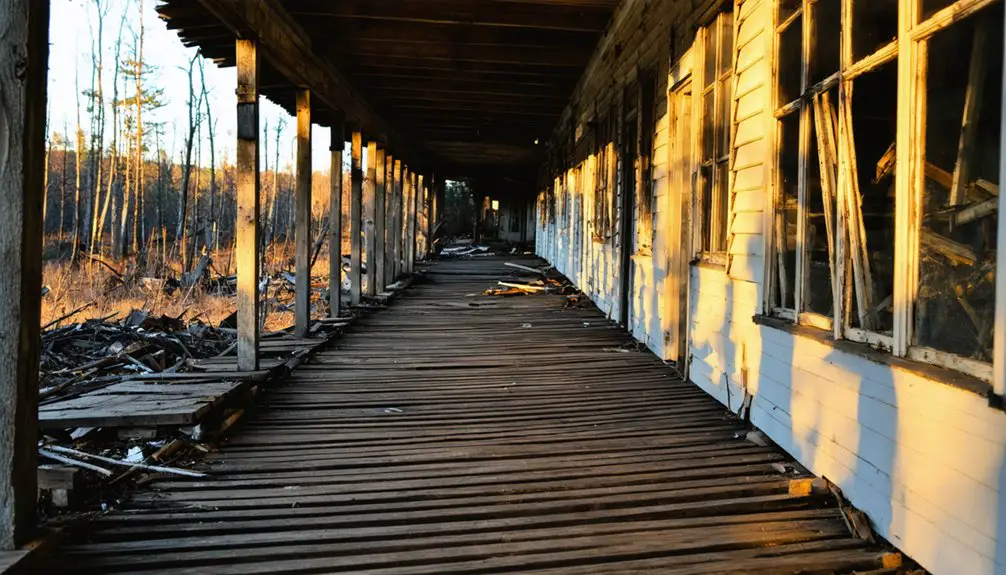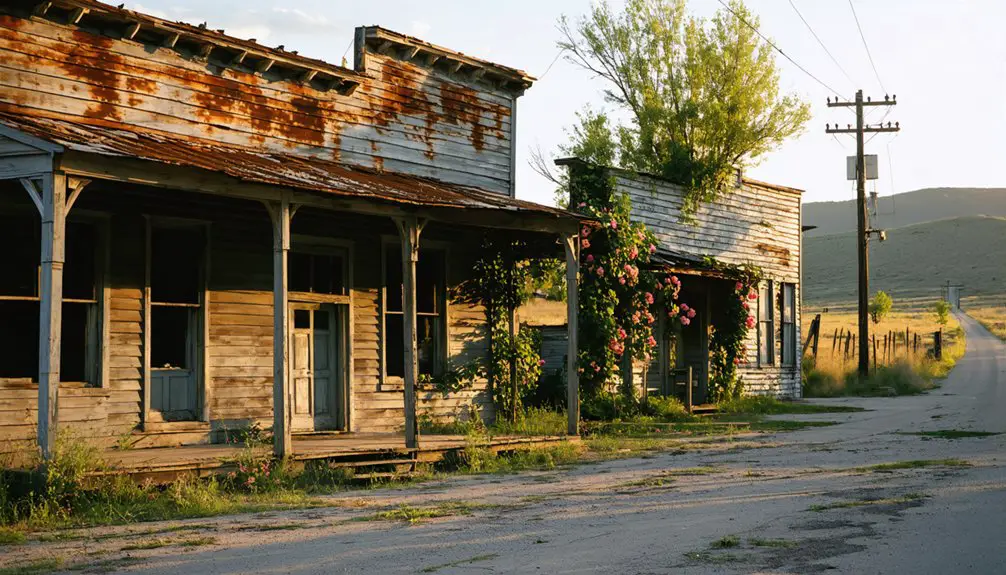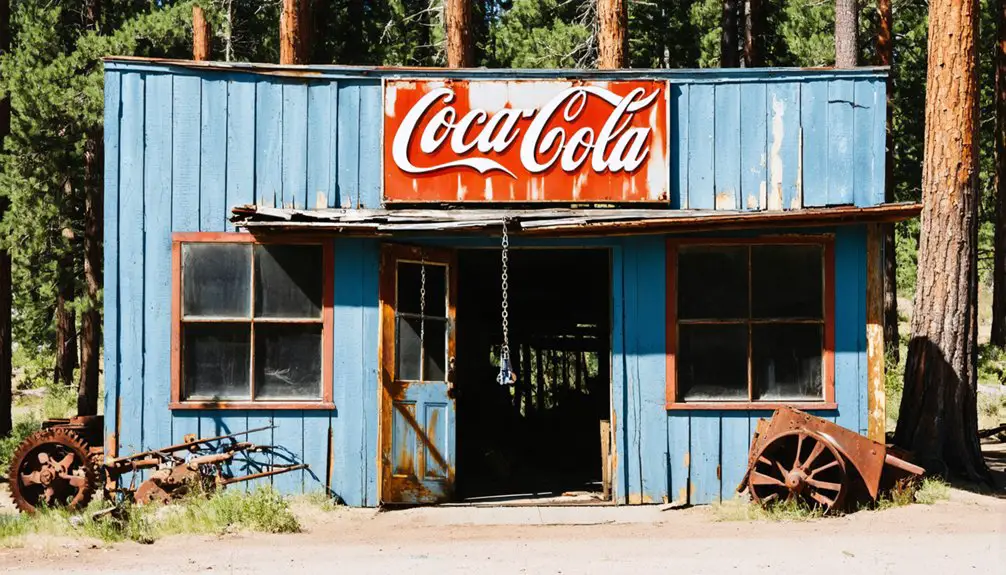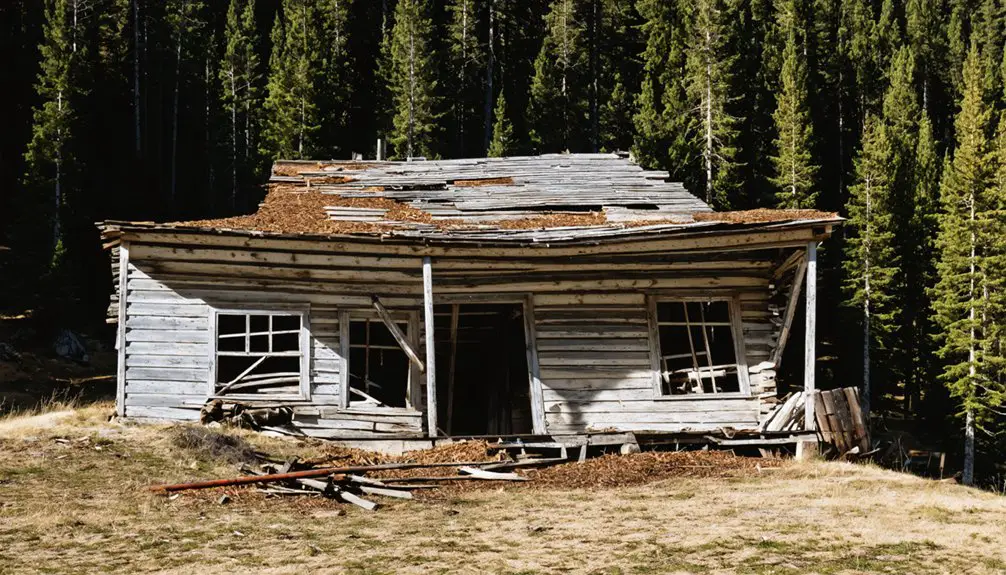You’ll discover Oregon’s highest ghost town perched at 6,300 feet, where an 1864 gold strike sparked Greenhorn’s meteoric rise. During its 1892-1904 heyday, this remote mining settlement boasted 3,200 residents, two hotels, multiple saloons, and a sophisticated waterworks system. The Bonanza and Red Boy mines yielded over $3 million before WWII regulations halted operations. While most structures have vanished, the 1910 jail and compelling legends still echo Greenhorn’s golden past.
Key Takeaways
- Greenhorn was a thriving gold mining town in Oregon that peaked between 1892-1904 with a population of 3,200 residents.
- Located at 6,300 feet elevation across Baker and Grant counties, Greenhorn was officially incorporated in 1903.
- The town’s gold mines produced over $3 million during peak years, with Bonanza Mine being one of the largest producers.
- Population declined dramatically to just 28 residents by 1910, accelerated by the 1942 federal ban on gold mining.
- Now a ghost town, Greenhorn’s historic structures and original infrastructure remain, attracting tourists and history enthusiasts.
The Birth of a Mining Frontier
When gold was discovered along Olive Creek in 1864, it sparked a rush that would give birth to one of Oregon’s most notable mining frontiers.
You’ll find Greenhorn’s origin story steeped in mystery, with some claiming its name came from a distinctive green uplift in the mountains, while others say it honors two inexperienced miners who struck it rich.
The settlement quickly grew southwest of Robinsonville, strategically positioning itself across both Baker and Grant counties along the Blue Mountain ridge.
By 1903, despite its rugged frontier nature and fluctuating population, Greenhorn had evolved enough to earn official incorporation as a city.
The area’s rich deposits, formed by ancient granitic intrusions 150-160 million years ago, would shape its destiny as a thriving mining community.
When Robinsonville burned down in 1898, Greenhorn stepped up to become the primary supply hub for the region’s mining operations.
Sitting at 6,306 feet above sea level, the town became one of Oregon’s highest-elevation mining settlements.
From Boom to Bust: Peak Mining Years
You’ll find that Greenhorn’s peak mining activity actually concentrated between 1892 and 1904, not 1910-1915, with operations like the Bonanza mine driving the district’s economic growth.
During this boom period, the town supported essential mining infrastructure and services, including a post office and local governance structure. The area’s extensive network of Chinese-built ditches helped facilitate successful mining operations throughout the district. At its height, the bustling town reached a population of 3,200 with numerous saloons and hotels serving the mining community.
The installation of a $150,000 sinking plant at the Bonanza mine in 1902, which reached a depth of 1,000 feet by 1903, exemplified the substantial investments made in mining operations during this prosperous era.
Peak Production Years 1910-1915
Between 1910 and 1915, Greenhorn reached its zenith as a thriving gold mining community, boasting a diverse infrastructure that included two hotels, multiple saloons, and essential services like a post office.
The town’s community growth reflected its economic success, with approximately 80 gold mines operating in the district. You’d find waterworks with fire hydrants, livery stables, and various mercantiles serving the bustling population. The first Locomobile car arrived in the town during this period, marking its technological advancement.
During this peak period, the district’s mines yielded impressive returns. The Bonanza Mine, featuring Oregon’s deepest shaft at 1,000 feet, and the Red Boy Mine each contributed around $1 million to the district’s total production of over $3 million.
Despite challenging conditions at 6,300 feet elevation and harsh winters, Greenhorn’s sophisticated mining operations and robust commercial sector defined its golden age.
Mining Support Businesses Flourish
During Greenhorn’s peak mining years, a diverse ecosystem of support businesses flourished to meet the demanding needs of the district’s 80 active gold mines.
You’d find multiple mercantile stores stocking mining equipment, while freight logistics operations from Baker City tackled the challenging task of transporting heavy machinery through snow-covered mountain passes.
The town’s fundamental mining support services included:
- Two livery stables providing essential pack animals for ore transport
- Multiple stamp mills offering ore processing capabilities
- On-site laboratories analyzing samples to optimize gold extraction
Technical services thrived as deep shaft mining expanded, with blacksmiths and repair shops maintaining crucial equipment. The Bonanza Mine emerged as one of the district’s largest producers, operating continuously since 1891. The region’s mines contributed to Oregon’s impressive gold and silver production of over $26 million between 1880 and 1899.
The town’s commercial infrastructure grew to include hotels, a post office, and several saloons, while water works with fire hydrants demonstrated Greenhorn’s commitment to protecting its business investments.
Economic Activity Drives Growth
As gold discoveries transformed Greenhorn in 1864, the region experienced unprecedented economic expansion that would last nearly eight decades.
Many inexperienced miners, known as greenhorns, flocked to the area seeking their fortune despite having no prior knowledge of mining techniques.
You’d find mining innovations revolutionizing operations, from early hydraulic methods to sophisticated shaft systems like the 1,000-foot Bonanza Mine, which deployed a $150,000 sinking plant by 1902.
The district’s economic fluctuations directly mirrored mining fortunes. When operations peaked, you could see over $3 million in total gold production driving the local economy.
The wealth supported modern utilities, waterworks, and diverse businesses by 1910. While the population swung dramatically – dropping two-thirds between 1900 and 1910, then surging from 10 to 352 by 1940 – mining prosperity sustained the region until federal restrictions in 1942 effectively ended the boom era. Weekly wages for miners reached an impressive $15,000 in 1936, showcasing the industry’s peak profitability during this period.
Life at 6,300 Feet: Challenges and Triumphs
Living at Greenhorn’s 6,300-foot elevation presented residents with unique challenges that shaped their daily existence. The thin mountain air caused high altitude health issues, requiring careful acclimatization and adaptation to prevent hypoxia. You’d have faced increased UV exposure, demanding vigilant skin and eye protection while working outdoors.
During the late 1800s mining operations, workers endured particularly harsh conditions while extracting gold from the mountainous terrain. Seasonal adaptations became vital for survival, with residents developing specific strategies:
- Stockpiling essential supplies before winter isolation
- Constructing specialized housing to withstand extreme weather
- Supplementing limited agriculture with hunting and gathering
You’d have experienced dramatically shorter growing seasons than Oregon’s lower elevations, while frequent snowfall and ice storms complicated travel and supply lines.
Despite these challenges, the community’s resilience showed through their innovative solutions to high-altitude living, from mining techniques to food preservation methods.
A Town’s Infrastructure Through Time

From its humble beginnings near the ruins of Robinsonville, Greenhorn’s infrastructure evolved into a remarkably thorough mountain mining town after its 1903 incorporation.
You’ll find evidence of the town’s historical significance in its early investment in essential services – a comprehensive waterworks system with fire hydrants, a bustling post office, and multiple commercial enterprises that served the mining community.
The infrastructure evolution reflected both practical needs and ambitious planning, with two hotels, multiple mercantiles, and livery stables supporting the town at 6,300 feet elevation.
While harsh winters challenged development, you can trace Greenhorn’s adaptability through its carefully planned facilities, including the jail built around 1910.
Today, though only seven homes remain standing, the town’s layout still reveals its thoughtful design amid the mountainous terrain.
Tales From the Mountain: Local Legends
You’ll find some of Greenhorn’s most compelling tales center on mysterious disappearances, including an entire building that vanished overnight without explanation.
The town’s historic jail, built in 1910, sparked particular controversy when it was secretly relocated to Canyon City, leading to prolonged legal battles between counties over jurisdiction.
These enigmatic events have become central to Greenhorn’s enduring folklore, drawing history enthusiasts and mystery seekers to this remote mountain settlement.
Vanishing Building Mystery
Among Greenhorn’s most intriguing tales, the overnight disappearance of an entire building in the early 1900s stands as a proof to the mysterious nature of this remote mining town.
While some attribute the vanishing to ghostly sightings, historical records suggest a more tangible explanation during the town’s turbulent mining era.
What you’ll find particularly fascinating about this case:
- The building served as an essential facility during Greenhorn’s peak development
- No official police records exist documenting the structure’s removal
- The incident occurred at an elevation of 6,300 feet, making any physical removal challenging
The mystery deepens when you consider this wasn’t an isolated incident – the documented relocation of Greenhorn’s jail to Canyon City demonstrates how entire structures could vanish from this mountain town, though the building’s fate remains unsolved to this day.
Jail’s Controversial Midnight Move
While the mystery of the vanishing building remains unsolved, another notorious disappearance from Greenhorn’s past has a documented, albeit contentious, ending.
The tale centers on the controversial jail relocation from Greenhorn to Canyon City, which occurred under the cover of darkness after the town’s decline. Built around 1910 during Greenhorn’s mining heyday, the jail’s ownership dispute erupted when it was mysteriously hauled away without community consensus.
Since Greenhorn straddled both Baker and Grant counties, the removal sparked legal battles between competing jurisdictions. The case landed in Grant County’s Circuit Court, where judges ultimately ruled the jail could remain in Canyon City.
You’ll find this former symbol of frontier justice still standing there today, a monument to the complex territorial conflicts that often plagued Oregon’s ghost towns.
The Great Population Decline

Although Greenhorn initially flourished as a gold mining settlement in the 1860s, the town experienced a dramatic population collapse between 1900 and 1910, losing two-thirds of its residents.
These significant population shifts stemmed from economic factors as the town evolved from placer to lode gold mining, leaving just 28 residents by 1910.
The transition from placer to lode mining devastated Greenhorn’s economy, driving away residents until barely two dozen remained.
The final blow to Greenhorn’s population came from three devastating events:
- The 1942 Federal Public Law 208 ban on gold mining during WWII
- The mass exodus of residents seeking work elsewhere
- The complete shutdown of the town’s primary industry
Preserving Greenhorn’s Legacy
Since Greenhorn’s decline into a ghost town, dedicated preservation efforts have focused on protecting its historical legacy through multiple approaches.
You’ll find historic preservation evident in the relocation of the 1910 Greenhorn Jail to Canyon City’s Herman & Eliza Oliver Museum, ensuring its survival for future generations. Original infrastructure, including waterworks and fire hydrants, remains as tangible links to the town’s peak years.
Community engagement plays an essential role through local historical societies and volunteers who maintain the site, conduct tours, and protect buildings from vandalism.
You can explore extensive documentation of the town’s history through census records, mine documentation, and oral histories. Museums in nearby towns showcase artifacts and photographs, while interpretive signage helps you understand the significance of remaining landmarks and structures.
Modern Day Ghost Town Adventures

Today’s adventurers can explore Greenhorn’s rich history through an array of modern tourism experiences. Ghost town tourism here offers immersive experiences that blend historical exploration with outdoor adventure.
You’ll find opportunities for guided tours and photography amid the abandoned structures, where nature steadily reclaims the landscape.
For the best experience at Greenhorn, consider these essential activities:
- Use AR-enabled apps to visualize the town’s historical appearance
- Join volunteer-led preservation projects to connect with local history
- Capture drone footage of the site’s unique architectural remains
While exploring, you’ll need to follow established safety protocols and obtain necessary permits.
Modern technology enhances your visit through interactive displays and QR codes that reveal stories of Greenhorn’s past, making history come alive as you navigate this fascinating Oregon ghost town.
Frequently Asked Questions
What Was the Average Daily Wage for Miners in Greenhorn?
You’d earn $4.00 for a grueling 12-hour shift in Greenhorn’s mining wages system around 1900, which aligned with the historical economy of Baker County’s bustling mining districts.
Were There Any Documented Deaths From Mining Accidents in Greenhorn?
While mining safety hazards existed, you won’t find specific documented deaths from mining accidents in Greenhorn’s historical records. Available sources don’t confirm any fatalities, though record-keeping may have been incomplete.
What Happened to the Native American Populations Around Greenhorn?
You’ll find Native cultures around Greenhorn were devastatingly displaced by the 1865 gold rush. Historical treaties couldn’t protect them as miners flooded in, forcing tribes to relocate or adapt to settler economies.
Did Greenhorn Have a School System During Its Peak Years?
You won’t find evidence of a formal school system during Greenhorn’s peak years. Historical records and archival documents don’t mention education infrastructure, likely due to the town’s small population and mining-focused priorities.
How Much Gold Was Extracted From Greenhorn’s Mines in Total?
You’ll find gold extraction records showing roughly 100,000 ounces through 1959, with mining techniques producing about $3 million total value from lode and placer operations combined.
References
- https://www.youtube.com/watch?v=k9lTFl9OtIY
- https://www.rvtravel.com/ghost-town-trails-greenhorn-oregon-rvt-1071/
- https://www.deviantart.com/austinsptd1996/journal/Six-Iconic-Ghost-Towns-Within-Oregon-1109696435
- https://westernmininghistory.com/towns/oregon/greenhorn-city/
- https://en.wikipedia.org/wiki/Greenhorn
- https://www.oregonencyclopedia.org/articles/greenhorn_mountains/
- https://www.oregon.gov/dogami/milo/pages/index-minemaps.aspx
- https://www.oregonencyclopedia.org/articles/greenhorn_mountains/pdf/
- https://westernmininghistory.com/gallery/6755/historical/towns/
- https://stage-sos.oregon.gov/archives/exhibits/ghost/Pages/mining-greenhorn.aspx



